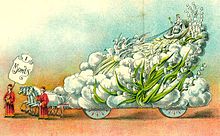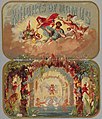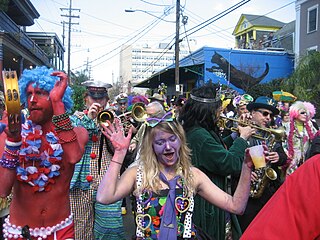
Mardi Gras is the final day of Carnival or Shrovetide before Ash Wednesday. Mardi Gras is French for "Fat Tuesday", reflecting the practice of the last night of consuming rich, fatty foods in preparation for the fasting season of Lent.

A krewe is a social organization that stages parades and/or balls for the Carnival season. The term is best known for its association with Mardi Gras celebrations in New Orleans, but is also used in other Carnival celebrations throughout Louisiana and along the Gulf of Mexico, such as the Gasparilla Pirate Festival in Tampa, Florida, Springtime Tallahassee, and Krewe of Amalee in DeLand, Florida with the Mardi Gras on Mainstreet Parade as well as in La Crosse, Wisconsin and at the Saint Paul Winter Carnival.

The Mistick Krewe of Comus (MKC), founded in 1856, is the oldest extant New Orleans, Louisiana Carnival Krewe, the longest to continually parade with few interruptions from 1856 to 1991, and continues to hold a tableau ball for its members and guests, to date. Initially its public facade was The Pickwick Club.

Rex is a New Orleans Carnival Krewe which stages one of the city's most celebrated parades on Mardi Gras Day. Rex is Latin for "King", and Rex reigns as "The King of Carnival".

The holiday of Mardi Gras is celebrated in southern Louisiana, including the city of New Orleans. Celebrations are concentrated for about two weeks before and through Shrove Tuesday, the day before Ash Wednesday. Mardi Gras is French for Fat Tuesday, the season is known as Carnival and begins on 12th Night, January 6th, and extends until midnight before Ash Wednesday. Club, or Krewe, balls start soon after, though most are extremely private, with their Kings and Queens coming from wealthy old families and their courts consisting of the season's debutantes. Most of the high society Krewes do not stage parades. As Fat Tuesday gets nearer, the parades start in earnest. Usually there is one major parade each day ; many days have several large parades. The largest and most elaborate parades take place the last five days of the Mardi Gras season. In the final week, many events occur throughout New Orleans and surrounding communities, including parades and balls.
The French Quarter neighborhood of New Orleans, Louisiana is the center of the city's Carnival celebrations, especially on Mardi Gras Day. This part of town is crowded with both tourists and locals, with the former more numerous in the Upper Quarter, the latter in the Lower Quarter. There are numerous parties and more than one costume contest. While the large motorized floats of the big parades have been prohibited since the early 1970s from going down the Quarter's narrow streets, numerous small marching krewes, parading jazz bands, and groups of revelers converge here. Some krewes parade in the Quarter after starting earlier in the day in other parts of town.

In Greek mythology, Comus is the god of festivity, revels and nocturnal dalliances. He is a son and a cup-bearer of the god Dionysus. He was represented as a winged youth or a child-like satyr and represents anarchy and chaos. His mythology occurs in the later times of antiquity. During his festivals in Ancient Greece, men and women exchanged clothes. He was depicted as a young man on the point of unconsciousness from drink. He had a wreath of flowers on his head and carried a torch that was in the process of being dropped. Unlike the purely carnal Pan or purely intoxicated Dionysos, Comus was a god of excess.
KOE, formally known as the Krewe of Elvis, is a Mardi Gras parading organization that consists of members from around the world who meet in New Orleans for Mardi Gras.
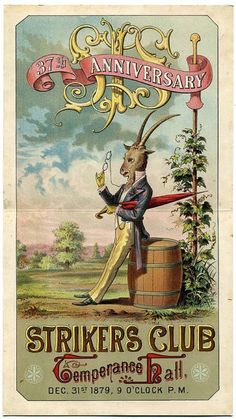
The Striker's Independent Society (SIS) is the oldest continuously active mystic society in Mobile, founded in 1843, Alabama. Mobile's Mardi Gras history spans over 300 years, as customs changed with the ruling nations: Mobile was the capital of French Louisiana in 1702, then British in 1763, then Spanish in 1780, entered the Republic of Alabama, was declared American in 1812, a U.S. state in 1819, then Confederate in 1860, then became American again in 1865 and participated in Carnival during New Year's Eve and New Year's Day celebrations. It is the oldest remaining mystic society in America but no longer hosts an annual parade.

Mardi Gras is the annual Carnival celebration in Mobile, Alabama. It is the oldest official Carnival celebration in the United States, started by Frenchman Nicholas Langlois in 1703 when Mobile was the capital of Louisiana. Although today New Orleans and South Louisiana celebrations are much more widely known for all the current traditions such as masked balls, parades, floats and throws were first created there. From Mobile being the first capital of French Louisiana (1702), the festival began as a French Catholic tradition. Mardi Gras has now evolved into a mainstream multi-week celebration across the spectrum of cultures, becoming school holidays for the final Monday and Tuesday, regardless of religious affiliation.

Mardi Gras throws are strings of beads, doubloons, cups, or other trinkets passed out or thrown from the floats for Mardi Gras celebrations, particularly in New Orleans, the Mobile, Alabama, and parades throughout the Gulf Coast of the United States, to spectators lining the streets. The "gaudy plastic jewelry, toys, and other mementos [are] tossed to the crowds from parading floats". The 'throws', consist of necklaces of plastic beads, coins called doubloons, which are stamped with krewes' logos, parade themes and the year, plus an array of plastic cups and toys such as Frisbees, figurines and LED trinkets. The plastic cups that are used as throws are sometimes referred to as New Orleans dinnerware.

A mystic society is a Mardi Gras social organization in Mobile, Alabama, that presents parades and/or balls for the enjoyment of its members, guests, and the public. The New Orleans Krewe is patterned after Mobile's Mystics. The societies have been based in class, economic and racial groups. Mobile's parading mystic societies build colorful Carnival floats and create costumes around each year's themes.

Mardi Gras in the United States is celebrated in a number of cities and regions in the country. Most of these places trace their Mardi Gras celebrations to French, Spanish, and other Catholic colonial influences on the settlements over their history.

The Krewe of Proteus (KoP) is a New Orleans Carnival Krewe founded in 1882, the oldest continuously parading Old Line Krewe.

The Intergalactic Krewe of Chewbacchus is a science fiction–themed Mardi Gras krewe, religious and parade organization, that also features fantasy and horror groups, among other fandoms. Based in New Orleans, Louisiana, as of the 2019 parade, the Intergalactic Krewe of Chewbacchus has over 2500 dues-paying members who call themselves "ChewbacchanALIENs" or "Chewbs."
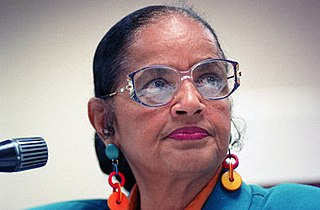
Dorothy Mae DeLavallade Taylor, was an educator and politician in New Orleans, the first African-American woman to be elected to and serve in the Louisiana House of Representatives. From 1971 to 1980, she represented District 20, since renumbered, in her native New Orleans. She had started her career as a teacher in the Head Start Program, designed to benefit children in their early years.

The Pickwick Club is a private gentlemen's club in New Orleans, Louisiana. Founded in 1857, The Pickwick Club and the Mistick Krewe were originally one group comprising two organizations. After The Boston Club, The Pickwick Club is the second oldest remaining in the city.
Knights of Chaos is an all-male New Orleans Carnival Krewe and rumored facade for the Knights of Momus.
Knights of Babylon is a New Orleans Mardi Gras krewe that was founded in 1939.
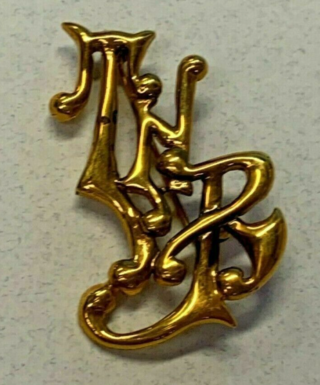
The Twelfth Night Revelers (TNR), founded in 1870, is a New Orleans, Louisiana, Carnival Krewe. It is the second oldest continuous organization of New Orleans Carnival festivities.

